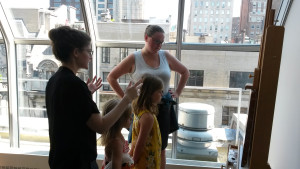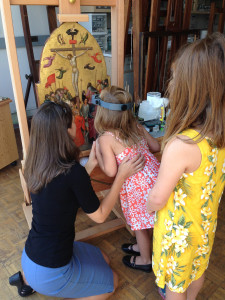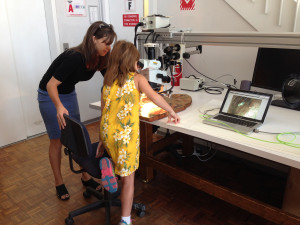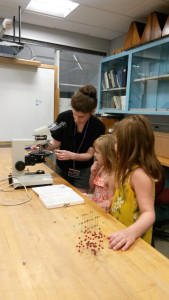by Sarah Mastrangelo
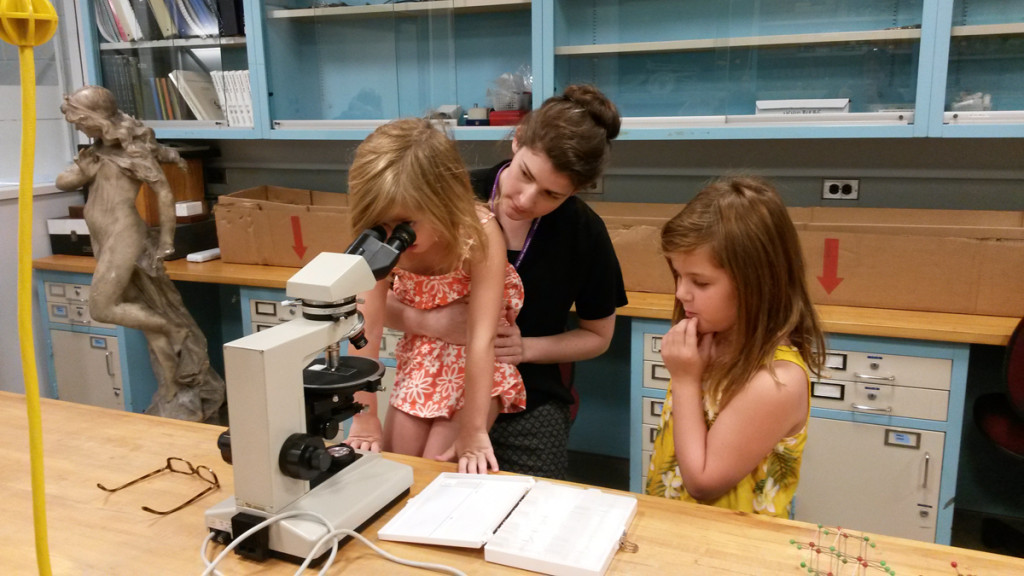
Examening a dispersed pigment sample
Education is never at rest, even during those short summer months that seem to slip away faster than they arrive. Recently, the Conservation Center at the IFA welcomed two young and insatiably curious visitors who understand well that the summer is without a doubt the best time to explore and learn new things.
It all starts with a bit of curiosity. Anna, a rising second grader, has recently developed a keen interest in the fine arts. Her trips to art museums have yielded questions including: How do paintings last so long? Who takes care of them? Are they all original? Along with her younger cousin Elizabeth, Anna got a behind-the-scenes tour of what we conservators do, the tools we work with, and the precautions we take to ensure the safety of the art and ourselves.
The majority of our tour took place in the paintings studio standing before two works from the Kress Collection. In order to make the complexities of conservation accessible, second year graduate student Sarah Mastrangelo began the discussion using a metaphor relating how time and the environment take their toll on things we care about: “If left outdoors, a favorite toy will discolor and fall apart over time. If we instead take care of the toy and make sure we put it away in a safe place away from bad weather, we will be able to keep it and enjoy it for longer. Conservators are interested in just that: maintaining precious cultural material in order for future generations to enjoy it.”
Conservation is a vast field of study with many different challenges. In the limited time we spent together, we focused on some tools and materials used in conservation. Rita Berg, Kress Fellow in Paintings Conservation, shared some of her treatment process for a late 14th century Crucifixion from the Mead Art Museum. She showed Anna and Elizabeth what gold leaf looks like and how it is applied to a panel painting. After discussing the inpainting process, our young visitors were able to try mixing colors on a palette as if they were matching an area of loss on the painting.
It is often necessary for conservators to work under magnification. Anna and Elizabeth used Optivisors to get a closer look at the painted figures on the panel. To look even closer at the egg tempura brushstrokes, we looked at the work using an Olympus SZX9 stereo microscope.
We discussed how it is important to understand materials used in a work of art. The paint on the early Italian panel is comprised of dry pigment bound in egg yolk. We looked at a few different types of pigments that would have been used by Italian Masters using a Nikon Labophot-POL polarized microscope and chatted about the different things they saw.
Anna and Elizabeth enjoyed their hands-on experience and were blown away by both the traditional techniques and ever-advancing technologies we use in conservation. Their curiosity proved that it is never too early to start learning about caring for things that are important to us.
